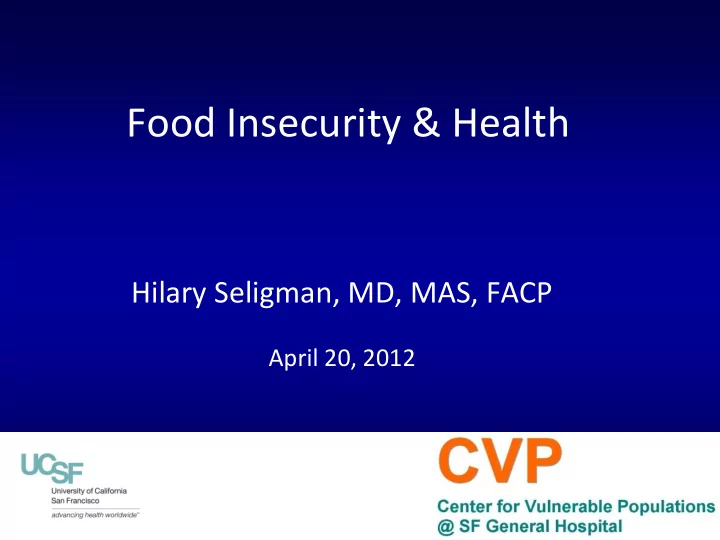

Food Insecurity & Health Hilary Seligman, MD, MAS, FACP April 20, 2012
Objectives 1. Briefly describe associations between food insecurity and health among children and adults 2. Using diabetes as a case example, discuss the intersection between food insecurity and chronic disease
Food Insecurity Among Children • Low birth weight & birth defects • Anemia due to iron deficiency • Colds & stomachaches • Cognitive delay & poor educational outcomes • Mental health symptoms • Increased utilization of health care (outpatient, psychiatric, Emergency Room) • Obesity??
Food Insecurity Among Adults • Obesity (women only) • Diabetes • Heart disease • Depression and fatigue • Poor health status
Food Insecurity Poor Health
Diabetes: Blood Sugar Balance • Drive Blood Sugar Up • Drive Blood Sugar Down Food Lack of food – Carbohydrates Diabetes medicine (pills • Sugars, starches, (& fiber) or insulin injections) Physical Activity HYPOGLYCEMIA: HYPERGLYCEMIA: Poor quality of life Blindness Cognitive dysfunction Amputations Seizures Kidney Failure Coma Death
Diabetes Self-Management • Reliable access to food • Diabetes-appropriate foods – Vegetables (and fruits) – Protein – Limited carbohydrates
Cycle of Food Insecurity & Chronic Disease: Diabetes Food Insecurity Cycles of Food Adequacy/Inadequacy Worsening of Competing Demands Poor Self-Management Capacity Competing Demands Increased Health Care Poor Diabetes Control Utilization Increased Diabetes Complications Adapted from Seligman HK, Schillinger D. N Engl J Med 2010;363:6-9.
Cycles of Food Adequacy and Inadequacy Hyperglycemia Hypoglycemia Seligman HK, Schillinger D. N Engl J Med 2010;363:6-9.
Hypoglycemia & Food Access • Inpatients (urban, safety net hospital) • 1/3 of those who reported hypoglycemia attributed it to the inability to afford food • Outpatient (community health centers): 38% food insecure • Blood ¡sugar ¡ever ¡gotten ¡too ¡low ¡because ¡you ¡couldn’t ¡ afford food (33% FI vs 5% FS) • Ever been to the ER because your blood sugar was too low (28% FI vs 5% FS) Nelson, JAMA, 1998; Seligman, JHCPU, 2010.
Food Insecurity and Hypoglycemia Of the 711 participants, 197 (28%) reported at least one significant hypoglycemic episode in the previous year. Secure 20 Insecure 16 4+ episodes: 12 % Adjusted OR 8 1.9 (1.1-3.5) 4 0 1-3 4-6 7-11 12+ Number of Severe Hypoglycemic Episodes *Adjusted model includes age, race/ethnicity, tobacco use, English proficiency, income, educational attainment, body weight, insulin, renal disease, adherence to medication and blood glucose testing, comorbid conditions, and alcohol abuse. Seligman, Arch Int Med , 2011.
Risk Factors for Hypoglycemia Adjusted OR Food Insecurity 3.0 (1.5-5.9) Alcohol abuse 2.2 (1.1-4.5) Comorbid illnesses 1.5 (1.1-2.0) Obesity 0.3 (0.1-0.7) Not significant: renal disease, insulin use, hypoglycemia knowledge, English proficiency, age, race/ethnicity, education, income, tobacco use, glucose monitoring, and medication adherence Seligman, Arch Int Med , 2011.
Cycles of Food Adequacy and Inadequacy Hyperglycemia Hypoglycemia Seligman HK, Schillinger D. N Engl J Med 2010;363:6-9.
Food Insecure Adults with Diabetes Have Higher Average Blood Sugars Food Food Secure Insecure Mean HbA1c (ICHC, n=711) 8.1% 8.5% p=0.007 Mean HbA1c (MFFH, n=621) 7.8% 8.4% p=0.002 Seligman, Diabetes Care, 2012 ; Seligman, in progress .
Food Insecure Adults with Diabetes Have Higher Average Blood Sugars 40 35 Food secure (n=354) 30 Food insecure (n=296) 25 20 % 15 10 5 0 <=7.0 7.1-8.0 8.1-9.0 9.1-10.0 10.1-11.0 >11 HbA1c Seligman, Diabetes Care, 2012 .
Cycle of Food Insecurity & Chronic Disease: Diabetes Food Insecurity Cycles of Food Worsening of Adequacy/Inadequacy Competing Poor Self- Demands Management Capacity Competing Demands Increased Health Poor Diabetes Care Utilization Control Increased Diabetes Complications Adapted from Seligman HK, Schillinger D. N Engl J Med 2010;363:6-9.
Poor Self-Management Capacity • Constrained dietary options – Decreased dietary variety – Increased fats, refined sugars – Increased sodium – Decreased fruits and vegetables and dairy • (Decreased physical activity)
“The ¡end ¡of ¡the ¡month, ¡I ¡start ¡getting ¡out ¡of ¡food…but ¡I ¡ have ¡to ¡eat ¡something, ¡‘cause ¡if ¡I ¡don’t ¡eat ¡behind ¡my ¡ [insulin] shot, that shot will make you so sick. I just eat anything I can find during that time just to keep me from ¡getting ¡sick.” Wolfe, J Aging Health, 1998
Patient-Related Factors Related to Higher Blood Sugar Food Food Insecure Secure p-value (n=325) (n=386) 64.3 49.0 <0.001 Difficulty following a diabetic diet, % Confidence in ability to manage 7.1 7.7 <0.001 their diabetes, mean score Emotional distress related to 3.9 3.0 <0.001 diabetes, mean score Seligman, Diabetes Care, 2012 .
Cycle of Food Insecurity & Chronic Disease: Diabetes Food Insecurity Cycles of Food Worsening of Adequacy/Inadequacy Competing Demands Poor Self- Management Capacity Competing Demands Increased Health Care Poor Diabetes Control Utilization Increased Diabetes Complications Adapted from Seligman HK, Schillinger D. N Engl J Med 2010;363:6-9.
Increased Need for HC Visits • Food insecure adults have about 5 more physician encounters per year than food secure adults • Hospitalizations in past year: 13% FI vs 8% FS • ED visits in past year: 28% FI vs 19% FS Kushel, Nelson
Competing Demands • Hunger in America 2010: 34% of clients reported having to choose at least once in the last 12 months between paying for food and paying for medicine or medical care • Food insecure patients more likely to put off buying blood testing supplies in order to afford food Seligman, JHCPU, 2010
Other Diet-Sensitive Chronic Conditions • Obesity • High blood pressure (salt) • Congestive heart failure (salt)*
Food Insecurity Poor Health
Feast-Famine in Animal Studies • Preference for calorically dense foods • Food hoarding • Aggression • Increase in body fat • Quicker weight gain with refeeding Townsend, 2001; Dietz, 1995.
Constrained Dietary Options Weight Diabetes Iron Def Gain Anemia Increased fats, refined X X sugars Reduced fruits, X X X vegetables, and dairy Reduced micronutrient ? ? X intake Bhattacharya, 2004; Kendall, 1996; Olson, 1999; Tarasuk, 2001; Tarasuk, 1999; Dixon, 2001; Lee, 2001
Thank You Hilary Seligman hilary.seligman@ucsf.edu
Recommend
More recommend